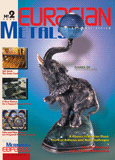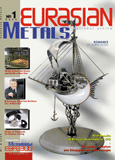Boris Kononenko
The ecological monitoring conducted recently in the Murmansk region showed that the situation there became much better by contrast with the past decade. In the opinion of researchers, both eastern and western parts of the Kola Peninsula are reasonably clean now and that is encouraging the development of tourism in this far northern area. Nikolai Bichuk, the chairman of the Murmansk region’s committee of natural resources, sees the reason for this change in reconstruction of industrial enterprises in the region, particularly those, which are incorporated in the Kolskaya Mining-and-Metallurgical Company, a subsidiary of Norilsk Nickel.
KOLSKAYA MINING-AND-METALLURGICAL COMPANY ENHANCES ECOLOGICAL STANDARDS
The Kolskaya Mining-and-Metallurgical Company founded 4 years ago comprises the Severonickel and Pechenganickel works that have copper, nickel and cobalt production capacities. These enterprises were built in 1937 and 1945 respectively and until recently they were using outdated technologies. Main production processes were resulting in significant hazardous emissions, which were the constant cause of public protests in the region as well as in neighboring Norway. There were no funds for modernization and scrapping of the production would inevitably lead to social disintegration in the cities of Monchegorsk, Zapolyarny and Nickel. So, along with high-liquidity product enterprises shareholders of Kolskaya had their hands full with problems.
 | Melting shop of the Pechenganikel works, Kolskaya Mining-and-Metallurgical company. Nikel settlement |
The company’s management defined the ecological safety of production as one of its strategic goals. Severonickel immediately started modernizing the technology of ore smelting, which was the leading source of dust and gas contamination. A shop for processing roasted copper concentrate has been completed. This technology will permit an increase in the extraction of sulfur dioxide for producing sulfuric acid and, thus, to reduce emissions of sulfur dioxide. A system for tail cleaning of process gases through the use of high-efficiency filters has been installed in the sulfur acid shop. Besides, gas flue channels of oxygen vertical converters have been reconstructed and emissions of metallurgical dust by boiling bed furnaces have decreased.
In 2001 the company invested more than 250 million rubles (over $8M) in constructing and reconstructing environment protection facilities located in the Monchegorsk area. As a result, emissions of contaminants became much lower than existing standards.
Reconstruction of the concentrator at Pechenganickel located close to the city of Zapolyarny and Nickel settlement is underway. This makes it possible to get richer concentrate already today. That is why with the same production volume at the metallurgical process stage it became feasible to reduce the number of smelting units and these very units are the major sources of hazardous emissions. There were previously six furnaces and now there are two. There were eight converters and today five of them remain. Emissions of contaminants decreased accordingly.
After the current reconstruction of the roasting shop is completed, the concentrate will be processed through briquetting, which sharply raises the extent of recycling sulfurous anhydride. Implementation of this project will lead to considerably less pollution in neighboring cities since volumes of sulfur dioxide emissions will be reduced ten-fold.
Results of the ecological program are already tangible. By contrast with the past decade emissions at the Pechenganickel works are reduced by 1.5 times and at Severonickel by five. Finally, the population is safer in the area with far less fear for their health. 
| 





 back
back



